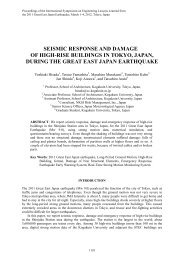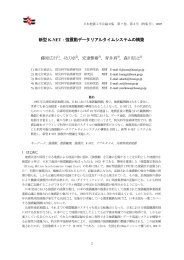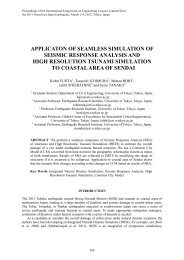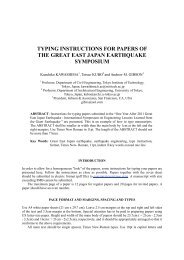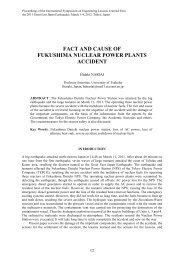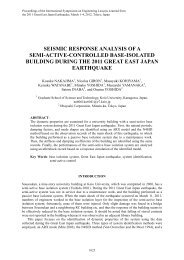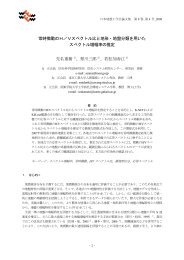Performance of High Rise Buildings under the February 27th 2010 ...
Performance of High Rise Buildings under the February 27th 2010 ...
Performance of High Rise Buildings under the February 27th 2010 ...
You also want an ePaper? Increase the reach of your titles
YUMPU automatically turns print PDFs into web optimized ePapers that Google loves.
Several indicators have been widely used throughout <strong>the</strong> years in Chile to evaluate <strong>the</strong> structuralcharacteristics <strong>of</strong> concrete buildings, with <strong>the</strong> intent to find a correlation between general structuralconception and successful seismic performance. The indicators presented are related only to globalresponse <strong>of</strong> buildings <strong>under</strong> earthquake loads and not to <strong>the</strong> behavior <strong>of</strong> individual elements. Toachieve a successful performance strategy, <strong>the</strong> adoption <strong>of</strong> an adequate general structural system mustbe properly complemented with <strong>the</strong> adoption <strong>of</strong> capacity design principles for <strong>the</strong> design and detailing<strong>of</strong> individual elements. The Macro approach is <strong>the</strong> definition <strong>of</strong> <strong>the</strong> global system, and <strong>the</strong> Microapproach are <strong>the</strong> principles behind <strong>the</strong> detailing <strong>of</strong> individual elements. They must be consistent withobjectives that define a successful seismic performance.Wall Density Indicator d np :Figure 5 shows <strong>the</strong> wall area in <strong>the</strong> first floor on each principal direction divided by <strong>the</strong> floor area <strong>of</strong>that floor, without consideration <strong>of</strong> <strong>the</strong> number <strong>of</strong> floors above. This ratio remains constant in timewith values in <strong>the</strong> range <strong>of</strong> 2-4%. Figure 6 illustrate <strong>the</strong> evolution <strong>of</strong> <strong>the</strong> Wall Density parameter d np .This parameter calculated as <strong>the</strong> wall area in <strong>the</strong> first floor on each principal direction divided by <strong>the</strong>total weight <strong>of</strong> <strong>the</strong> floor area above this level with units <strong>of</strong> (m 2 /ton), (Gómez 2001 & Calderón 2007).In <strong>the</strong> last 60 years <strong>the</strong>re has been trend to a continuous reduction <strong>of</strong> <strong>the</strong> average wall densityindicator. Never<strong>the</strong>less a constant minimum <strong>of</strong> 0.001 is observed. This is consistent with <strong>the</strong> basiccriteria, described previously, for <strong>the</strong> determination <strong>of</strong> <strong>the</strong> wall area required in each principaldirection, assuming a unit weight per floor area <strong>of</strong> 10 KPa (1.0 ton/m 2 ).The inverse <strong>of</strong> this indicator has units <strong>of</strong> MPa (ton/m 2 ) and is directly related with <strong>the</strong> averagecompression forces and <strong>the</strong> seismic shear forces acting on <strong>the</strong> walls. A decreased value <strong>of</strong> <strong>the</strong> walldensity indicator implies a direct increase in wall compression and shear stresses. The use <strong>of</strong>sophisticated structural analysis s<strong>of</strong>tware and <strong>the</strong> use <strong>of</strong> higher strength concrete have led to <strong>the</strong> use <strong>of</strong>relatively thin walls, resulting in brittle behavior and poor performance when subjected to large lateraldisplacements. Different authors have demonstrated (Massone, 2011) that <strong>the</strong> maximum ro<strong>of</strong> lateraldisplacement is dependent <strong>of</strong> <strong>the</strong> relation c/l w that is directly related with <strong>the</strong> axial load, <strong>the</strong> geometryand reinforcing <strong>of</strong> <strong>the</strong> wall. Walls with L or T shape and setbacks are especially vulnerable to thissituation due to large compression stresses at <strong>the</strong> web when subjected to large lateral displacements.Evidence shows that an important percentage <strong>of</strong> <strong>the</strong> damaged walls fall in this category. This type <strong>of</strong>situation is usually present in modern buildings below ground level where larger spaces for parkingfacilities are needed.Wall density values above 0.001m 2 /ton in each principal direction have proven to provideadequate earthquake behavior when properly designed. It becomes evident that design <strong>of</strong> shear wallsmust follow capacity design principles to provide an individual ductile behavior in order to guaranteea global successful behavior for <strong>the</strong> building <strong>under</strong> large lateral displacements. General practice, withsome exceptions, prior to 2008 did not follow <strong>the</strong>se principles due to <strong>the</strong> Chilean code exclusion <strong>of</strong> <strong>the</strong>ACI 318 requirement for transverse reinforcement in boundary elements in walls. This made wallsvulnerable when subjected to large displacements such as <strong>the</strong> observed on s<strong>of</strong>t soils in Concepción,Viña del Mar and Santiago.Stiffness Indicator H / T:Proposed by Guendelman (2000) it is <strong>the</strong> quotient <strong>of</strong> <strong>the</strong> Total Height <strong>of</strong> <strong>the</strong> building (H) divided by<strong>the</strong> First Translational mode period <strong>of</strong> <strong>the</strong> building calculated from spectral analysis (T). The unitsare meters/sec. which represents a velocity. Figure 7 show historical values from a database <strong>of</strong> 2622Chilean buildings (Guendelman, <strong>2010</strong>). Values <strong>of</strong> H/T are in <strong>the</strong> range <strong>of</strong> 20 – 160 m/sec. Valuesbelow 40 m/sec. apply to flexible mostly frame buildings; values between 40 and 70 m/sec. representnormal stiffness buildings and values over 70 m/sec. pertain to stiff buildings.Historically, Chilean buildings can be classified in <strong>the</strong> range <strong>of</strong> stiff to normal according to <strong>the</strong>stiffness indicator.1759




